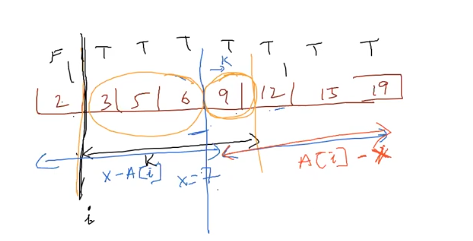Binary Search continued ....
Two kinds of problems we can solve using Binary Search
- Explicit Search Problems
- Optimization Problems (monotonic)
Capacity to Ship Packages within D days
Cues : Optmization Problem.
- min/max { x } st $f(x) \le threshold$ or $ f(x) \ge threshold$
- $f(x)$ should be monotonic wrt x
here $x: capacity$ while $RT : f(x)$ , RT : # round trips
Triming Search space :
left = $max {A[j]}$ because capacity should be greater than max elt to load it on cart!
right = $ \Sigma A[j]$ we can send all of them in 1 go
-
Search Space = [ $ max(A[j]), \Sigma A[j]$]
-
Predicate

This is F* T* with first T being answer to solution.
int getRoundTripTime(int C, vector<int>& weights){
int i, curr_load = 0, rt = 0;
for(i = 0; i < weights.size(); i++){
if(curr_load + weights[i] <= C)
curr_load += weights[i];
else{
rt++;
curr_load = weights[i];
}
}
// Count the last trip
rt++;
return rt;
}
int shipWithinDays(vector<int>& weights, int D){
int n = weights.size(), i, lo, hi, mid, max_wt=INT_MIN, sum_wt = 0;
for(i = 0; i < n; i++){
max_wt = max(max_wt,weights[i]);
sum_wt += weights[i];
}
lo = max_wt, hi = sum_wt;
while(lo < hi){
mid = lo + (hi-lo)/2;
if(getRoundTripTime(mid,weights) <= D)
hi = mid;
else
lo = mid+1;
}
return lo;
}
Key point worth noticing here is that the distance of other values from pivot point is like a inverted pyramid. difference array should be monotonic.
Now can we predict dif(i+k) from dif(i)
So solution is $dif(i) \le dif(i+k)$

we are interested in finding the value of $i$ using binary search.
Predicate : $p(i)$ : $x-A[i] \le A(i+k)-x$
vector<int> findClosestElements(vector<int>& arr, int k, int x){
int n = arr.size(), lo, hi, mid;
arr.push_back(10001);
lo = 0, hi = n-k;
while(lo<hi){
mid = lo+(hi-lo)/2;
if(x-arr[mid] <= arr[mid+k]-x)
hi = mid;
else lo = mid+1;
}
return vector<int>(arr.begin()+lo, arr.begin()+lo+k);
}
Upper bound of answer is n+1
First approach is to DAT (Direct Addressing Table) O(n) (time) with O(n) : space.
Second Approach
-
Go thru the array , change the -ve number to INT_MAX
-
go thru the array for i -> arr[i]
$arr[arr[i] - 1] = -1*ar[ar[i]-1]$ if $arr[arr[i] - 1] > 0$
-
Go thru the array, return $i+1$ for the first $i$ such that $arr[i] $> 0
Ideas
- DAT
- Use the input array and the space
- Preserving 2 things
- Value
- Vi
Simple straight forward problem.
Search row and then search column. Complexity $O(\log m + \log n)$
or think of a single sorted array! :)
bool searchMatrix(vector<vector<int>>& matrix, int target) {
int n = matrix[0].size();
int m = matrix.size();
int i,j,mid;
int lo = 0,hi = m*n-1;
while(lo<hi){
mid = lo+(hi-lo)/2;
i = mid/n;
j = mid%n;
if(matrix[i][j] >= target) hi = mid;
else lo = mid+1;
}
i = lo/n; j = lo%n;
if(matrix[i][j] == target) return true;
return false;
}
This is simple to see.
Can we find $O(m+n)$ solution ? We have to reduce the search stage by at least one row or column in each iteration.
Initial SS of size : $m*n$
Final SS of size : 1
Total No. of step : $m+n$
How much to reduce SS by ? either m or n;
Now which cell allows us to reduce search space by m or n ? It must be
- max in row , min in col
- min in row , max in col
We can do a top-right or bottom-left search :
This approach make every search space a prefix submatrix of original matrix.
bool searchMatrix(vector<vector<int>>& matrix, int target) {
int n = matrix[0].size(),int m = matrix.size();
int i = 0, j = n-1;
while(i < m && j >= 0){
if(matrix[i][j] == target) return true;
// Ignore the column.
if(matrix[i][j] < target)
i++;
else
j--;
}
return false;
}
There is greedy solution first take max frequency element which will give some idea of minimum cycles.
AAAABBBCCDE , n = 4
A _ _ A _ _ A _ _ A
Now we can fill smaller task on the gaps
A B _ A B _ A B _ A // this way they won’t wrap around :
A B C A B C A B D A
A B C E A B C A B D A // we can fill/create new slots in E if we want
Now say more than 1 task with max frequency
AAAA DDDD CCCC FFFEE , n = 3
ADCFEADCFEADCFADC
we see last DC are extra…
more e. g. AAAA DDDD CCCC F , n = 3
ADCFADCI ADCI ADC
I : idle we inserted !
max_count : Total number of task with max_freq
max_freq : frequency of the task which takes the most cycles.
gaps <- n
two cases
- max_count - 1 >= gaps
- max_count - 1 < gaps
int leastInterval(vector<char>& tasks, int n) {
int m = tasks.size();
vector<int> freq(26,0);
int max_freq = 0, max_count;
for(auto task : tasks){
freq[task-'A']++;
if(freq[task-'A'] == max_freq)
max_count++;
else if(freq[task-'A'] > max_freq){
max_freq = freq[task - 'A'];
max_count = 1;
}
}
// n gaps between two As
if(max_count-1 >= n) return m;
int count_processed = max_count * max_freq;
int rem_count = m - count_processed;
int total_gaps = (n - (max_count-1)) * (max_freq-1);
if(total_gaps <= rem_count) return m;
total_gaps -= rem_count;
return m + total_gaps;
}